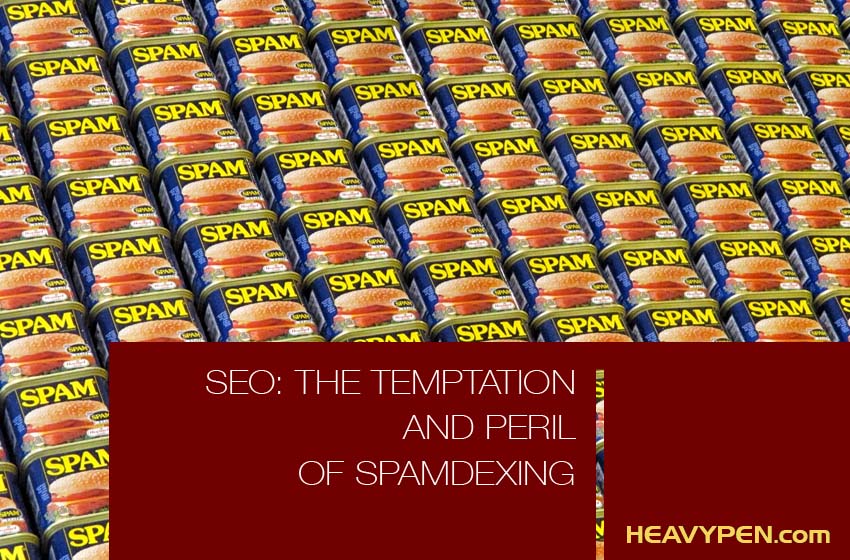
The Temptation (and the perils) of Spamdexing
Tempted to “fix” bad website ranking with some SEO tricks? Confessions from a former Spamdexer.
First, full disclosure – I am a recovered spamdexer – and once on Google’s short list of targets for blacklisting. Second, I coined the phrase spamdexing during a phone call in 2005, accidentally conflating the words “spam” and “indexing.” It stuck with me; now everyone uses it.
What is Spamdexing?
Spamdexing is what you do when you deploy search engine tactics designed to manipulate search queries. The goal is to increase a target site’s search ranking to generate traffic.
Back in 1997-99, spamdexing worked pretty well for web pages in the simple search engines that we had back then. But it’s an unsustainable hack. While spamdexing may get you short-term gains, there are long-term penalties.
As for me, I tried just about any form of black-hat SEO I could conjure up and sneak into a website. And I was pretty successful — for a while. This website once ranked in the top 100,000 in the Alexa ranking schema.
After many years and many sins, Heavypen.com was blacklisted. I did a total update about twenty years ago, and the site recovered. Still, getting back into Google’s good graces took a lot of work.
This goes to show you that the stain of spamdexing can last a bloody long time.
12 Spamdexing Tactics
The good news is that habitual spamdexers grow fewer and fewer with each algorithm refresh. The search engines have gotten better at tamping down the loopholes. With so many other safe alternatives, there’s no upside.
- Invisible keywords – found in graphics, tags, and links – is an old method that can often get a site banned.
- Link farming – another oldie. Pages that point to a variety of unrelated sites.
- Link networking – massive linking between unrelated sites using keywords to simulate relevance.
- Link referencing – links to massive sites like Wikipedia as references. Not so bad, still allowed, but there’s a way to do it right.
- Doorway Pages – This was one of my favorites. I’d build a low-quality page with a headline, a list of keywords (and their variants) and hyperlinks to similar pages.
- Ghost linking – hidden reciprocal links to link farms on each page of the site. Definitely a “get you banned” tactic.
- Keyword stacking, Meta-tag Stuffing – dozens of keywords ‘stacked’ on the lead paragraphs on multiple pages. Includes generous slathering of keywords in metatags. It probably will not get you banned or delisted, but won’t do you any good either.
- Auto-generated keyword pages, including AI-generated blogs – These pages often focus on one or more targeted keywords. Nowadays, they use AI to autogenerate junk text that’s just a lot of junk.
- Replicated content – Reuse old blog posts and articles and reposition them for new campaigns. While this tactic can work, but most of the time people don’t do it correctly and they end up with duplicated junk.
- Duplicated location pages – e.g., for location pages; adding city names to page titles, headlines, and text. Again, there’s a way to do this correctly, but most people don’t, and the search engines will just ignore them.
- Article “spinning” – AI is fueling this tactic today: produce one article, then produce dozens of iterations with simple rephrasing. Some will just replace adjectives. Another tactic that won’t get you banned, but Google and Bing are way ahead of you on this one.
- Mass article submission schemes – usually associated with spammy backlink and guest posting schemes. Often involves fake blogger pages and private blog networks (PBNs). This tactic actually works, to a degree. But, come on, spamdex is spamdex.
This list is by no means all there is in the word that is spamdex. Per my earlier admission – I used some of these tactics myself going as far back as 1997 when Heavypen first launched. As I noted, some spammy tactics still work, but this site is a living testament that nearly all of them will eventually stop working. The question is, besides pay-per-click advertising, how else can you get into the face of your audience?
Effective SEO is no Quick Fix
Nearly all quick fix methods (even the good ones) can end up harming your website if not executed and managed carefully.
Not too long ago, we were encouraged to build up our backlinks. For a while, you could purchase them. Not anymore. Do engage link building, but do not buy them.
We used to purchase exact match domains (for example: the-best-treehouse-plans.com). That tactic doesn’t work anymore, either.
I used to create a page for keyword variations for products or services offered. Now, we must be careful about using one keyword too many times. For example, in this article, I’ve probably overused “spamdexing.”
Some have proclaimed that SEO is dead. Well, it isn’t. We just have to stop thinking of SEO as an easy fix for attracting inquiries and engaging target audiences.
As always, being effective takes a little time and hard work; being ineffective is a race to hell and back. When people ask me for a “secret sauce” for better search engine ranking, there’s only one way:
- Engage your target audience on social media platforms.
- Use tools like Google Analytics and Google Search Console to plan your SEO strategy.
- Write solid blog posts and articles to attract potential customers.
- Deploy structured data, give complete metadata, and use alt tags.
- Build landing pages that match search intent.
- Create other types of content like videos, infographics, and podcasts that blend with marketing campaigns.
- Encourage relevant linking.
In short, create content with the intent of engaging a specific audience.
Are the Search Engines Punishing Us?
Search engines are the gatekeepers of information, guiding users through the vast expanse of the internet. Yet, this role isn’t without its challenges, particularly navigating the murky waters of spam. The question arises: Are search engines punishing us?
The answer lies in the search engines’ imperative to provide quality, relevant search results to their users. In the early days of the internet, a plethora of search engines vied for dominance, each with varying degrees of success in filtering out undesirable content. The landscape was cluttered, and the sheer volume of spam and irrelevant information often compromised user experience. This was a pivotal moment for search engines; those unable to effectively curtail the spammer’s influence dwindled, leaving the field to the few who could.
Enter the likes of Google, Bing, Yahoo, Yandex, DuckDuckGo, and a few others. These entities have not merely survived; they have thrived by learning a critical lesson: to protect their audiences, they must manage the content that reaches them. Thus, while the penalties and rules may seem rather onerous, they come from a desire to protect their audience.
How Search Engines Make Themselves Useful
What measures have search engines taken to protect audiences? For one thing, search engines have gotten sophisticated in their battle against spammers. They constantly refine algorithms to recognize and devalue tactics like keyword stuffing, cloaking, and link schemes. Regular updates are rolled out to stay ahead of the ever-evolving spamming techniques, making it increasingly difficult for spammers to game the system.
Moreover, search engines have emphasized the user experience, rewarding sites that provide genuine value, engaging content, and a seamless navigation experience. Metrics like site speed, mobile-friendliness, and secure browsing have become critical in determining a website’s search ranking.
Search engines are not wielding their power to punish but to protect. They safeguard the quality of their content, ensuring that their platforms remain valuable resources for users. This protective stance has a dual benefit: it encourages website owners and SEO practitioners to adopt ethical, user-focused practices while ensuring that users can trust their web searches offer relevant information.
The evolution of search engines from a crowded field of contenders to a select few powerhouses underscores the importance of quality control in the digital age. By managing us — the content creators and optimizers — search engines protect their most precious asset: their audience. This is not punishment; it is a necessary stewardship of the internet’s vast and ever-expanding informational landscape.

A Dose of SEO Common Sense
So, what do we do?
Well, we can try to invent more spammy methods, or we can ground ourselves in a fundamental principle: Market to the target, not the machine. Engage your traffic, not the keywords. Focus on conversion, not your ranking.
This mantra, rooted deeply in Old School wisdom, serves as the ultimate antidote to the temptations of spamdexing. It is a straightforward idea that speaks to a profound truth that escapes those caught up in the frantic race for search engine supremacy.
Yes, achieving a high-level position on your targeted Search Engine Results Pages (SERPs) is important. It’s a visible indicator of your website’s visibility and, by extension, its potential to attract visitors. However, this pursuit becomes futile if it loses sight of the ultimate goal: delivering value to your audience. What’s the point of all this digital marketing if your audience struggles to find the information they need or, worse, finds themselves mired in a wall of spam?
The key to sustainable SEO success lies not in tricking the system but in engaging with the people who use it. And there are some pretty easy-to-deploy methods that can help you create meaningful, relevant content that addresses the needs and interests of your target audience, and guess what? You could spend less money.
At the end of the day, it’s not just about being seen; it’s about being valued and trusted by your audience.
Good hunting!
About: Ray Wyman, Jr is a content creator, communications professional, and author with more than 30 years of experience. Visit LinkedIN or Raywyman.com for more information.


